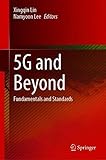5G and Beyond [electronic resource] : Fundamentals and Standards / edited by Xingqin Lin, Namyoon Lee.
Contributor(s): Lin, Xingqin [editor.] | Lee, Namyoon [editor.]
| Lee, Namyoon [editor.] | SpringerLink (Online service)
| SpringerLink (Online service) .
.
Material type:  BookPublisher: Cham : Springer International Publishing : Imprint: Springer, 2021Edition: 1st ed. 2021.Description: VIII, 543 p. 215 illus., 146 illus. in color. online resource.Content type: text Media type: computer Carrier type: online resourceISBN: 9783030581978.Subject(s): Telecommunication
BookPublisher: Cham : Springer International Publishing : Imprint: Springer, 2021Edition: 1st ed. 2021.Description: VIII, 543 p. 215 illus., 146 illus. in color. online resource.Content type: text Media type: computer Carrier type: online resourceISBN: 9783030581978.Subject(s): TelecommunicationIntroduction to 5G and Beyond -- Part I: Fundamentals of 5G and 6G -- Advanced Channel Coding -- Multiple Access Techniques -- Massive MIMO -- Fundamentals of Network Densification -- UAV-enabled Cellular Networks -- 6G Wireless Systems: Challenges and Opportunities -- Part II: 5G New Radio Basics -- A Guide to NG-RAN Architecture -- NR Physical Layer Overview -- NR Channel Coding -- 5G NR Cell Search and Random Access -- A Primer on Bandwidth Parts in 5G New Radio -- Part III: 5G New Radio Evolution -- Support of Ultra-Reliable and Low-Latency Communications (URLLC) in NR -- 5G New Radio in Unlicensed Spectrum -- 5G NR Positioning -- NR Integrated Access and Backhaul -- Sky High 5G: New Radio for Air-to-Ground Communications -- 5G New Radio Evolution Meets Satellite Communications: Opportunities, Challenges, and Solutions.
This book provides an accessible and comprehensive tutorial on the key enabling technologies for 5G and beyond, covering both the fundamentals and the state-of-the-art 5G standards. The book begins with a historical overview of the evolution of cellular technologies and addresses the questions on why 5G and what is 5G. Following this, six tutorial chapters describe the fundamental technology components for 5G and beyond. These include modern advancements in channel coding, multiple access, massive multiple-input and multiple-output (MIMO), network densification, unmanned aerial vehicle enabled cellular networks, and 6G wireless systems. The second part of this book consists of five chapters that introduce the basics of 5G New Radio (NR) standards developed by 3GPP. These include 5G architecture, protocols, and physical layer aspects. The third part of this book provides an overview of the key 5G NR evolution directions. These directions include ultra-reliable low-latency communication (URLLC) enhancements, operation in unlicensed spectrum, positioning, integrated access and backhaul, air-to-ground communication, and non-terrestrial networks with satellite communication.


There are no comments for this item.